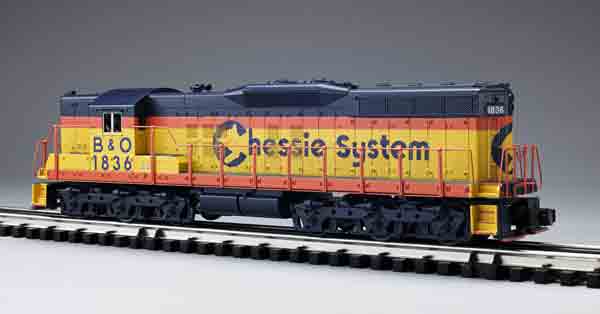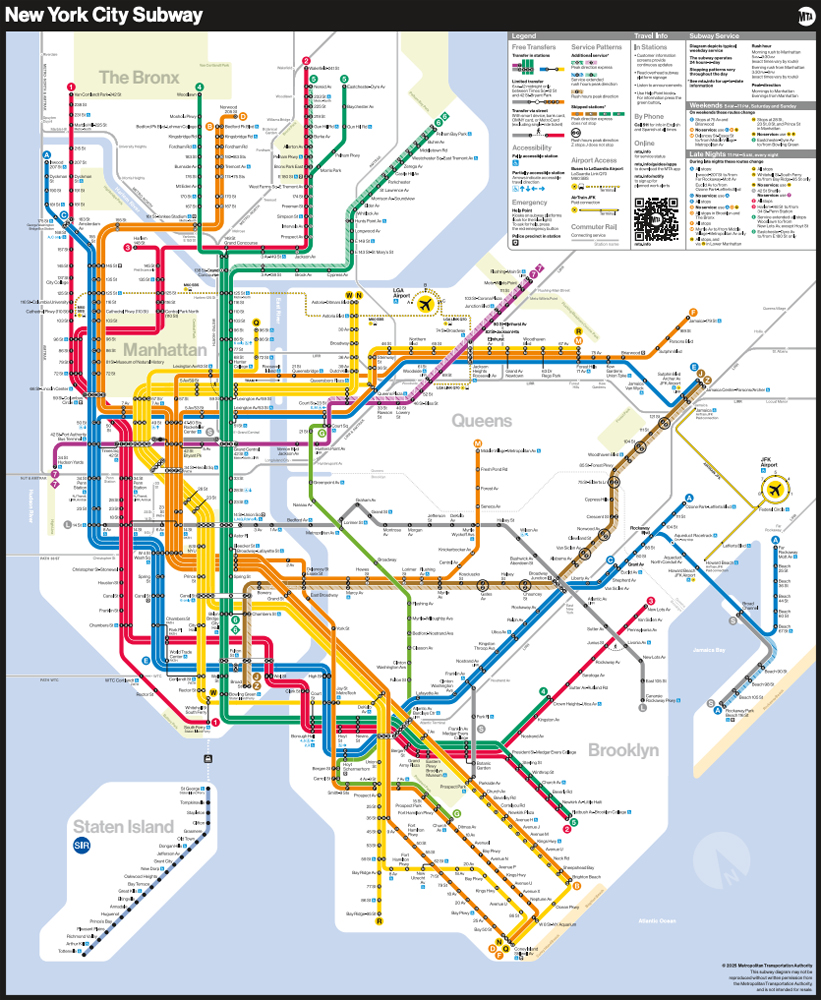Price: $329.95 (The no. 30-20196-1) Chessie System (B&O)
Features: O-31 operation, has a metal frame, and die-cast metal trucks and couplers, two can-style motors, an operating smoke unit, and coil couplers, and ProtoSound 3.0 command and sound system.
Current run road names: Chessie System (B&O), Great Northern, Norfolk Southern, and Southern Pacific
While the general silhouette was similar to that of the Geeps working the local branch lines, the paint scheme (from an ore-hauling road) made it stand out even surrounded by a fleet of F units and GP9s. It looked rugged, and the six-wheel trucks helped it look macho compared to the four-axle jobs surrounding it. I mean, this baby hauled ore, while the engines surrounding it were just shuffling grain cars in from Osnabrock! The only other 12-wheeled power in the area were the daily SD40-2s hauling coal trains through the Forks on the way to Minnesota. So, for a few days it was the heaviest power staying in town. And it earned a footnote in my own little train logbook!
The 1,750-horsepower SD9 (SD for “Special Duty”) was made from 1954-59, and 471 were built for American railroads. David P. Morgan, editor of Trains magazine, wrote in the February 1966 issue “The 990 [a demonstrator unit] was indifferent about what it locked couplers with, and hauled transfer runs, mixed trains, drags, and passenger expresses indiscriminately. It also took on yard, hump, and helper assignments without blinking a headlight bulb.”
Six motors and trucks designed to better distribute weight for branch lines made this locomotive the right tool for many jobs. The initial owners of SD7s and SD9s included Class 1 railroads, railroads owned by U.S. Steel, and ore-hauling lines. A few SD9s have been preserved or are reported to be in occasional service.
Opening the box
My first impression after opening the box was “Geep on steroids,” which I guess is what an SD9 actually is. As with the prototype, the O gauge SD9 is longer than a GP7 or GP9; the dimensions and the three-axle trucks make the differences clear.
Although this is a RailKing diesel, it uses the tooling for the old Premier line SD9. The pilot has a cast-in uncoupler arm and brakeman’s steps with safety texture. The short hood has cast-in ladder detail leading upward and cast-in grab irons and lift rings up top. There is also an add-on cap representing the sand fill plug.
The handrails are all add-on wire, and the railings on the end have a safety chain over the center at the drawbridge.
The roof of the long hood has an add-on horn just ahead of the cab by the blister. I tugged at the blister to see if it would come off and expose any surprises, but found it is firmly in place. The smoke and sound controls are on the underside of the frame. Speaking of smoke, two ports for smoke fluid are on each side of the blister. You’ll find two cast-in fans on the blister and four more near the end.
The cab has clear plastic panes in the front and rear windows and crew figures facing long-hood front. If you look at the front corner of the running board, you’ll find an “F,” indicating the long hood is the “foward” facing direction for this diesel.
The cast-in detailing on the side is very good, starting with the brake blister and the end-of-unit air intakes. On the body, the detailing is raised and not cut into the side of the shell. The hinge, latch, and louver detailing is fairly deep, and as I like to note, it is something you can feel with your fingertip. Of note are the latches running along the side of the frame. Don’t know what these would have allowed access to, but they look like there must be important gear inside!
The fuel tank houses the speaker. It has a simulated sight gauge and two simulated tanks. The truck sideframes are designed for the Flexi-Coil three-motor truck and are well-executed die-cast metal pieces.
Several times in the late 1970s and early ’80s, I had an opportunity to railfan along the Baltimore & Ohio line from Newark to Mansfield, Ohio, and became something of a fan of the eccentric Chessie System three-color paint scheme. It was a crazy design, but did a good job in indicating the subsidiary railroads being transitioned into a single system, while preserving a bit of individual identity with “B&O,” “C&O,” or “WM” on the cabs. Chessie the cat, illustrated in the jumbo “C,” was the ultimate link to the past. The three-color scheme was nicely applied to the MTH model, especially over the end of the long hood. It looks pretty sharp.
On the test track
The RailKing model features the MTH ProtoSound 3.0 sound and command system. In command mode operation was flawless and the locomotive was immediately responsive to command. As is typical with the Digital Command System, it takes just a few keystrokes and a few seconds to load all the data for the model into the remote controller. But you don’t need DCS to operate this model when operating using a conventional transformer throttle. You still have the DCS speed-control system that delivers low starting speed, the basic sound package, and the smoke units.
Each truck has three axles, but just the two outermost trucks are powered. The innermost truck is flangeless. The center wheels on both trucks have traction tires. Each truck has a single power pickup roller on the middle axle. The rollers are separated by approximately 6½ inches.
Sound reproduction was great. It is deep and throaty, letting you know this is a serious piece of locomotion.
Smoke output was intense from the first application of power. As I’ve noted before, after I do a function check, off goes the smoke, lest I trigger the smoke alarm and fire sprinklers. I don’t want to have to pay for the 200-odd computers in the building!
Operational performance was first rate. Our command-mode low-speed average was 2.8 scale mph, and the conventional low speed was 2.7 scale mph. Our high speed was 62 scale mph.
Drawbar pull was 2 pounds, 5 ounces.
Running this O gauge model was a lot of fun. It is powerful and surprisingly robust considering that it “looks like a Geep!” The MTH RailKing SD9 is a good model of an often forgotten first-generation diesel. It was a powerful diesel that could operate on a main corridor or light traffic branch with ease. The RailKing SD9 is a solid model that could be just the utility player your freight operations can use.













